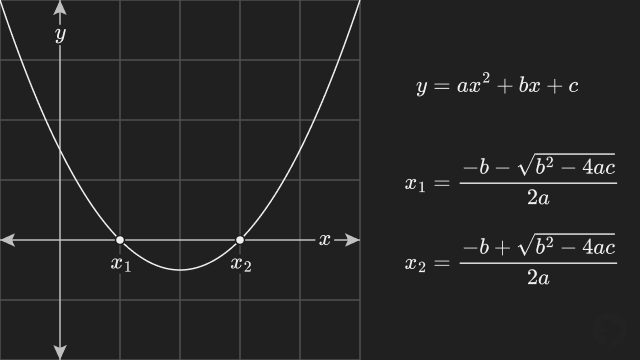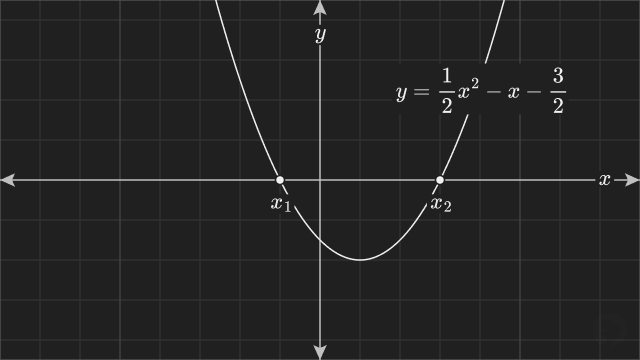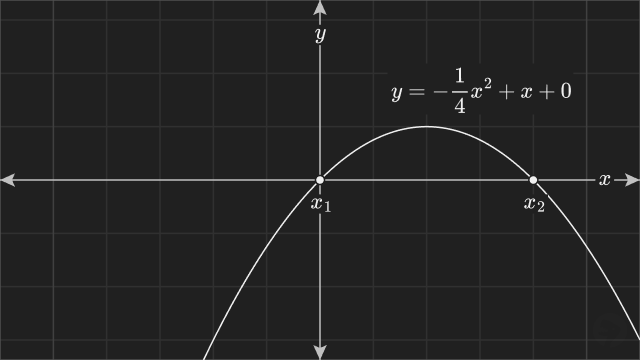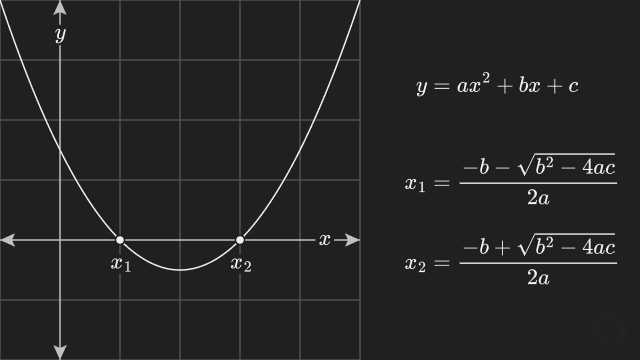Quadratic Formula

The quadratic formula calculates the -intercepts of a quadratic equation which forms the shape of a parabola. The formula is useful when a quadratic equation cannot be easily factored.
Formula Terms
| Expression | Description |
|---|---|
| The second-degree coefficient | |
| The first-degree coefficient | |
| The zero-degree coefficient |
The quadratic formula returns the intercepts of a quadratic equation. For example, the quadratic equation shown below is difficult to factor and so is a good candidate for using the formula.
Applying the quadratic formula to the equation above, we are able to find the roots of the equation. Substituting , and into the formula gives us the expression below.
Then, after some simplification and expanding the (plus-minus symbol) into two expressions we are left with the intercepts of the equation.

This example demonstrates applying the quadratic formula to the quadratic equation shown in the plot above and in the equation below. The formula returns the places where the parabola crosses the -axis, also called the roots of the equation.
Note, applying the quadratic formula is the same as setting the equation equal to zero and solving for as shown in the expression below.
Start by setting up the quadratic formula.
Substitute the coefficients of the quadratic formula into equation. In this case, substitute , and into the formula.
Simplify the expression by evaluating arithmetic within the square root operator and in the denominator.
Evaluate the division and square root operator.
Expand the (plus-minus symbol) into two solutions representing the positive and negative result of the square root operator.
The two roots of the quadratic equation are and .

This example demonstrates applying the quadratic formula to the quadratic equation shown in the plot above and in the equation below. The formula returns the places where the parabola crosses the -axis, also called the roots of the equation.
Note, applying the quadratic formula is the same as setting the equation equal to zero and solving for as shown in the expression below.
Start by setting up the quadratic formula.
Then substitute the coefficients of the quadratic formula into equation. In this case, substitute , and into the formula.
Simplify the expression by evaluating arithmetic within the square root operator and in the denominator.
Evaluate the division and square root operator.
Expand the (plus-minus symbol) into two solutions representing the positive and negative result of the square root operator.
The two roots of the quadratic equation are and .
The quadratic formula can be derived from setting the quadratic equation equal to zero and solving for [1].
Visually, a quadratic equation forms the shape of a parabola and the formula returns the points where the parabola intersects with the axis as shown in the figure below.

Given values for the coefficients , and of the quadratic equation, the quadratic formula will produce two results because the square root operator returns both a positive and negative solution. This is explicitly shown by expanding the (plus-minus) symbol into two separate expressions.
Sometimes the quadratic equation does not intersect with the -axis as is the case with the quadratic equation below. When this happens, applying the quadratic formula will result in a negative number as input to the square root operator.
For example, applying the quadratic formula to this equation gives the following expression.
This indicates that there is no solution, unless you expand the domain of the input to complex numbers.
The other edge case with this formula is if the input equation isn’t quadratic, meaning that the coefficient . In this case, the formula results in a divide by zero error.
-
Derive Quadratic Formula